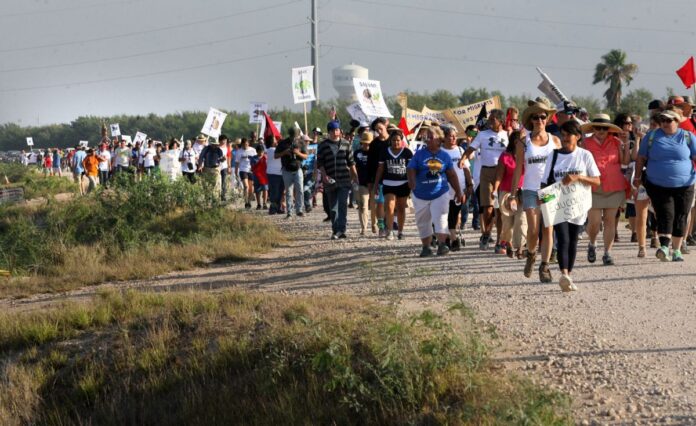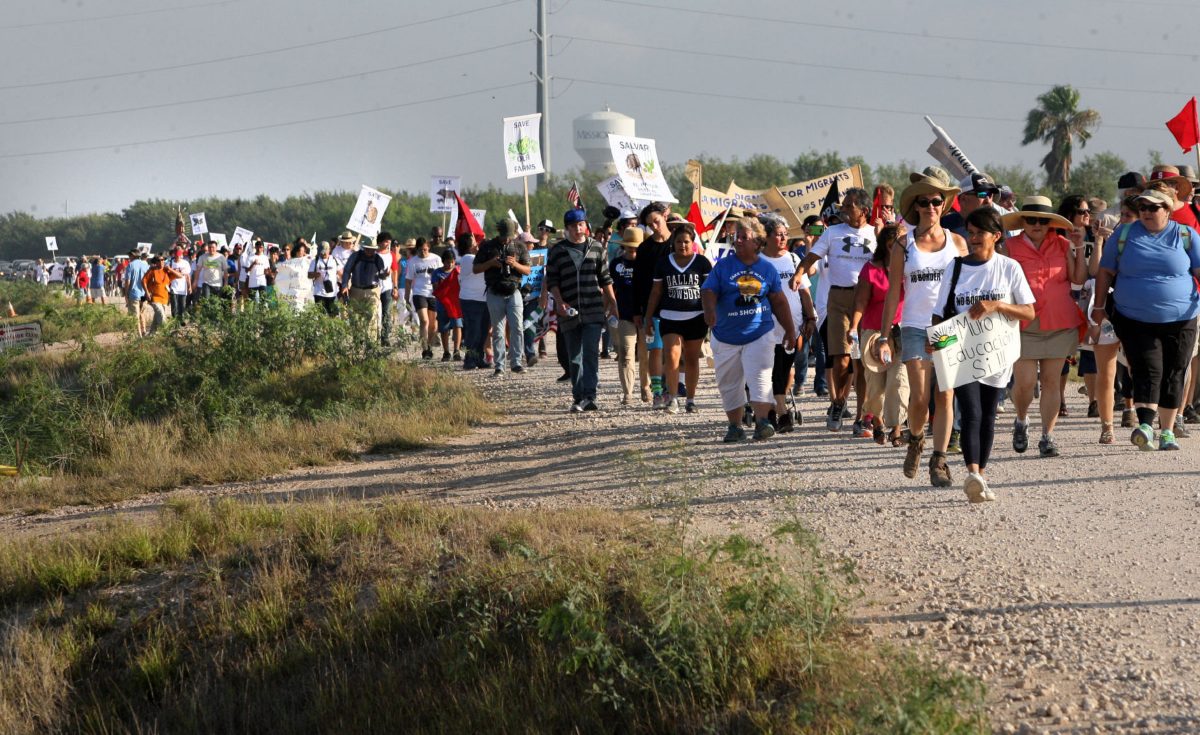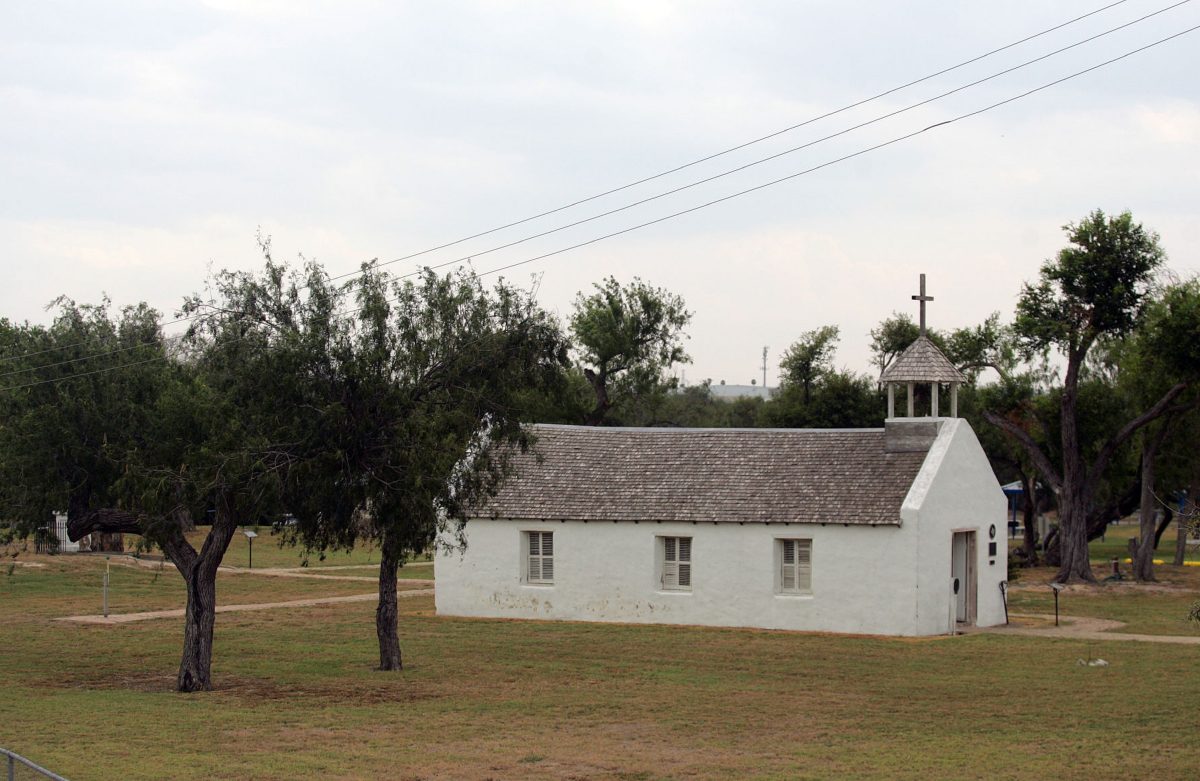MISSION — Pulling into the parking lot of the Mission church you might’ve thought people were gathering for a rock concert. People stood outside putting the finishing touches on signs protesting the wall as “Proud Mary” played loudly from the church’s PA system, and the sun began to peek outside the Our Lady of Guadalupe church.
Just before 7 a.m. Saturday several hundred people gathered outside the church in the heart of Mission as they prepared to march four miles south to where government contractors want to erect a wall that would close off a historic shrine located 100 feet from the Rio Grande. Simultaneously, with the secular music in the background, the bells rang out as the final attendees for the march signed in and filled out postcards addressed to the decision-makers in Washington, hoping that those who will potentially fund the construction of the wall here — hear their amplified voices.
Before departing for the chapel, Father Roy L. Snipes, a Catholic priest who has been with the church for more than 25 years, and who helped in the efforts to stage the march, recited a few words from the Bible as the event got underway.
The protest, the result of a culmination of the efforts between numerous organizations that oppose the wall, was planned as a means to unite different groups against a government bent on placing a wall throughout the entire U.S./Mexico border.
Word spread quickly last month when it was confirmed by government officials that preliminary planning for the Trump Administration’s much talked about border wall had begun at one of the most prestigious pieces of land in the region, the Santa Ana National Wildlife Refuge. Last week came word of plans for 28 miles of border wall in Hidalgo County to be placed on the levees, affecting private landowners and other areas in the Rio Grande Valley.
Flanked by several hundreds of protesters, Father Roy led the march from his church, down four miles south, to the La Lomita Chapel, a more than 100-year-old structure founded by Oblate Missionaries in the mid to late 1800s.
Positioned in the driver’s seat inside a baby blue, four-door 1984 Ford Escort that had a nearly five-foot statue of the Lady of Guadalupe affixed to it, Father Roy, accompanied by at least a few of his dogs, slowly drove south to where the chapel stands.
Chants of “Si se puede!” from marchers and the eclectic choice of music from Father Roy’s tiny Ford Escort reverberated down South Conway Avenue as police escorted the hundreds who braved the heat to come together and voice their displeasure with the plans for the wall.
Some walked, others used golf carts, and rode bikes as they waved banners and signs with slogans such as “No walls between amigos.”
Juan Mancias, 62, of Floresville, was one of many who came from outside the Valley to join the march. Mancias, the chairman of the Carrizo/Comecrudo Nation in Texas, said he was there to represent his tribe and show solidarity for those against the wall.
“We’ve been here since first contact, we are the original people of Texas, we are the original people of the peyote,” he said. Beating a drum as he made his way down the four-mile trek he said the land here is his people’s land, where his tribe lived until they were pushed out decades ago.
His group, along with nearly 40 others like his, participated in the event that was designed to underscore the importance of the region, of the chapel, and of the river that it stands next to.
Stefanie Herweck, an executive committee member of the Lower Rio Grande Valley Sierra Club, a local chapter of the national nonprofit environmental organization, has been at the forefront of the this fight, and others like the one in Brownsville opposing liquefied natural gas plants.
She points to the Rio Grande, the river a mere 100 feet from the chapel, as a symbol of the uniqueness of the region.
“Increasingly we’re marginalizing the river, we’re leaving the river behind. We’re not even actually aware of this thing that created our communities,” she said. “For me that’s a really tragic loss of a center, of a cultural, natural, and some would say spiritual center, of our community — that’s why we’re (holding this event), to highlight how important the river is and how much we want to maintain our connection with that.”
John-Michael Torres, spokesman for La Union Del Pueblo Entero, a local immigrant advocacy group, said they joined the event to show their support and to continue to push back against the destruction of public spaces.
“The wall would be both an ecological disaster and a human disaster because border militarization has increased over the years,” Torres said.
He said building more walls leaves migrants crossing into the country in increasingly perilous situations, increasing the risk of death.
“The solution would be recognizing the need for immigration reform,” Torres said. “To be able to allow people to reunite with their families, find work, to cross the border legally, rather than trying to stop people and trying to force people into more dangerous places — erecting these barriers that are very destructive.”
In an emotional speech, Jeffrey Glasberg, President of the North American Butterfly Association, said it was the first time in three weeks he had left his home, after his wife, who along with him co-founded the National Butterfly Center in Mission, died.
The butterfly center was the spot where on July 20 government contractors were found trespassing on private undeveloped land.
Representatives from the Center for Biological Diversity were also on hand to show support.
The organization in July expanded its lawsuit against the Department of Homeland Security and U.S. Customs and Border Protection, related to the border wall prototypes, to include the 14-miles of fencing proposed in the San Diego area.
The added claims state that the two agencies are violating the National Environmental Policy Act with respect to both the border wall prototype project and the 14-mile border wall-replacement project.
Paulo Lopes, a public lands policy specialist with the center based in Washington D.C., said that in both cases Homeland Security and CBP have completely failed to conduct any prior environmental analysis or involve the public in the decision-making process.
After the nearly two-hour march ended more than 750 people gathered at the historic chapel to hear traditional mariachis play, listen to poetry from local activists, and hear from several guest speakers with different organizations like the North American Butterfly Association in the fight against what some deemed “police state” actions from the government.
Kids were also treated to activities, ice-cold popsicles, pan dulce and a chance to break down a border wall, albeit a piñata designed to look like a section of a border wall.
The 72-year-old priest said he believes that if a border wall is built near the historic shrine, the very namesake of the town would be cutoff from the rest of the county, and cutoff from a symbol of enduring peace along the border.
“It looks like (the structure) could even wall-off the La Lomita chapel — which is part of our parish — from us and it would wall-off the river from us,” he said. “It would be awful, I just, it would be too sad, I hope it won’t happen.”
Father Roy said he was aware of the construction plans but has yet to be invited to any meetings with government officials like those who have met with CBP officials, regarding the wall.
“I don’t think they asked. You might’ve thought when they saw they were going to wall-off a chapel that they would’ve asked the pastor or even the bishop. Would you like to know what’s going on,” he said. “Maybe they still will and I hope (they do).”
The priest, who moved to the Valley in 1968, holds camps yearly for members of the congregation and others on the riverside land that surrounds the church, but he fears the camps will be done away with if the chapel is between a wall and the river.
During the camps he takes kids down to the river and teaches them to fish and how to find bullfrogs, among other activities; memories that he said stay with the kids for the rest of their lives.
Whether Father Roy will be able to continue to use the chapel and the surrounding land is yet to be decided as the U.S. Senate still has to decide by the end of September if it will fund the wall for $1.6 billion requested by the administration and approved by the House earlier this month.
“We don’t want a giant wall. We want to be able to go to the chapel, we want to go down to the river, take our shoes off and fish,” Father Roy said. “I want to teach these kids to fish in the river.”
WHAT: Border Residents Rally against Border Wall at Santa Ana
WHEN: Sunday, Aug. 13, 9 a.m.
WHERE: Santa Ana National Wildlife Refuge, Old Military Highway 281 one-fourth mile east of Alamo Road, Alamo








